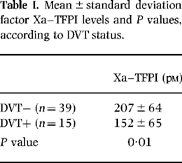PRE-OPERATIVE FACTOR Xa–TFPI AND POST-OPERATIVE VENOUS THROMBOSIS
Patients undergoing total hip replacement surgery have a high risk of developing post-operative venous thromboembolism and for many years clinicians have sought pre-operative blood tests that can identify patients with the highest risk ( Bauer, 1993). Factor Xa is a pivotal enzyme of blood coagulation since it is the enzyme component of prothrombinase and tissue-factor pathway inhibitor (TFPI) is the most potent of the plasma inhibitors of factors Xa in vitro. Whether increased factor Xa production or decreased ability to inactivate factor Xa in vivo favours the development of post-operative deep vein thrombosis (DVT) is unknown. We have shown previously that factor Xa–TFPI is as effective an antiprothrombinase as TFPI in vitro, and that factor Xa–TFPI probably regulates factor VIIa–tissue factor in vivo ( Gouin-Thibault et al, 1996 ). Our results also suggested that factor Xa–TFPI better reflects endogenous antiprothrombinase potential than TFPI ( Gouin-Thibault et al, 1996 ).
We therefore investigated whether the concentrations of factor Xa–TFPI endogenous to plasmas can potentially identify patients with the highest risk for post-operative thromboembolic events in a prospective randomized double-blind study that compared a low molecular weight heparin (LMWH) prophylaxis versus placebo in patients undergoing total hip replacement surgery performed under spinal anaesthesia and gradual compression stockings ( Samama et al, 1997 ). Blood was collected from a subgroup of 54 patients (25 receiving placebo, 29 receiving LMWH) on the day before surgery (pre-op.) and the concentrations of factor Xa–TFPI in the plasmas were measured by ELISA ( Gouin-Thibault et al, 1996 ). The means were compared, according to the assigned treatment group and the presence or absence of DVT, using Student t-tests, and a P value of < 0.05 was considered to be statistically significant.
Significantly higher levels of factor Xa–TFPI were found in the pre-operative plasmas of patients without DVT (207 p M) compared to the levels found in plasmas of patients who developed post-operative DVT (152 p M) ( Table I). Similar concentrations of factor Xa–TFPI were found in the pre-operative plasmas of the placebo and the LMWH groups (data not shown). These results are consistent with factor Xa–TFPI having an important regulatory action on thrombin generation in patients at high risk for thrombosis, as it does in healthy individuals ( Gouin-Thibault et al, 1996 ).

The plasma concentrations of prothrombin fragment 1 + 2, thrombin–antithrombin III and fibrinopeptide A reflect thrombin formation, inhibition and activity respectively and are sensitive tests for estimating coagulation in vivo. Other available tests measure concentrations of D-dimer, the degradation product of cross-linked fibrin, and plasmin–antiplasmin, tPA antigen and PAI activity that assess activation of fibrinolysis. Two retrospective studies ( Tripodi & Mannucci, 1996; van Beek et al, 1996 ) and one prospective study ( Ginsberg et al, 1995 ) have shown that groups of patients developing post-operative venous thrombosis or pulmonary embolism have elevated levels of markers reflecting increased coagulation activation. In our study we showed that pre-operative plasmas of patients who remained DVT-free had higher factor Xa–TFPI levels than plasmas of patients with post-operative DVT, suggesting an important role of factor Xa–TFPI as a regulator of factor VIIa–tissue factor and prothrombinase in vivo. Larger studies are also necessary to determine a role for factor Xa–TFPI in decreasing post-operative DVT rate, and the potential value of pre-operative factor Xa–TFPI and the other markers of haemostasis for identifying patients at higher risk for post-operative thromboembolism.




